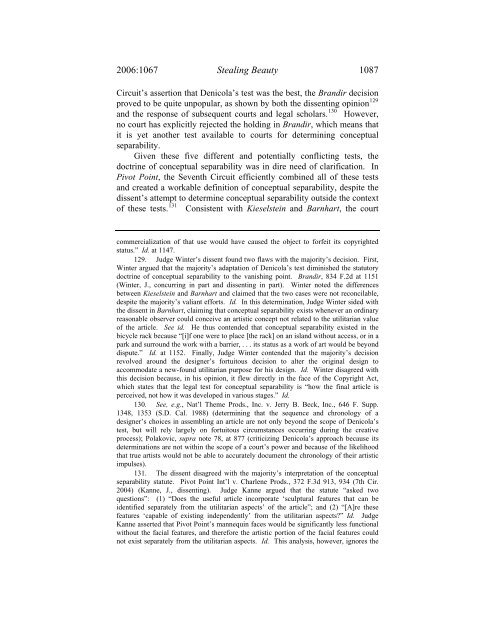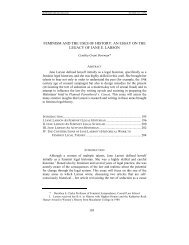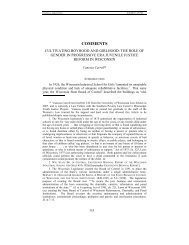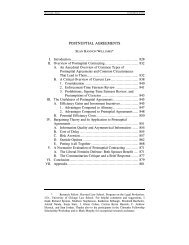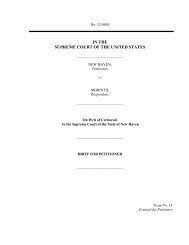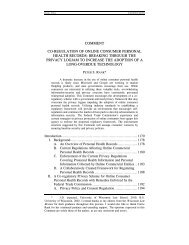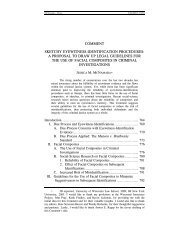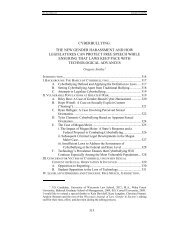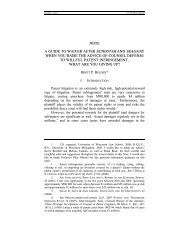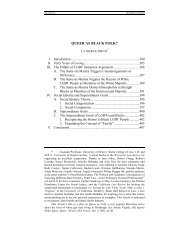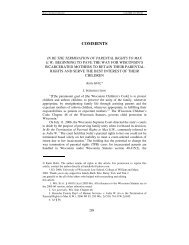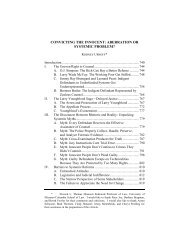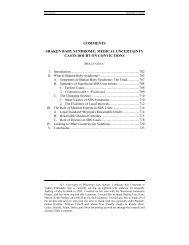Stealing Beauty: Pivot Point International v ... - UW Law School
Stealing Beauty: Pivot Point International v ... - UW Law School
Stealing Beauty: Pivot Point International v ... - UW Law School
You also want an ePaper? Increase the reach of your titles
YUMPU automatically turns print PDFs into web optimized ePapers that Google loves.
2006:1067 <strong>Stealing</strong> <strong>Beauty</strong> 1087<br />
Circuit’s assertion that Denicola’s test was the best, the Brandir decision<br />
proved to be quite unpopular, as shown by both the dissenting opinion 129<br />
and the response of subsequent courts and legal scholars. 130 However,<br />
no court has explicitly rejected the holding in Brandir, which means that<br />
it is yet another test available to courts for determining conceptual<br />
separability.<br />
Given these five different and potentially conflicting tests, the<br />
doctrine of conceptual separability was in dire need of clarification. In<br />
<strong>Pivot</strong> <strong>Point</strong>, the Seventh Circuit efficiently combined all of these tests<br />
and created a workable definition of conceptual separability, despite the<br />
dissent’s attempt to determine conceptual separability outside the context<br />
of these tests. 131 Consistent with Kieselstein and Barnhart, the court<br />
commercialization of that use would have caused the object to forfeit its copyrighted<br />
status.” Id. at 1147.<br />
129. Judge Winter’s dissent found two flaws with the majority’s decision. First,<br />
Winter argued that the majority’s adaptation of Denicola’s test diminished the statutory<br />
doctrine of conceptual separability to the vanishing point. Brandir, 834 F.2d at 1151<br />
(Winter, J., concurring in part and dissenting in part). Winter noted the differences<br />
between Kieselstein and Barnhart and claimed that the two cases were not reconcilable,<br />
despite the majority’s valiant efforts. Id. In this determination, Judge Winter sided with<br />
the dissent in Barnhart, claiming that conceptual separability exists whenever an ordinary<br />
reasonable observer could conceive an artistic concept not related to the utilitarian value<br />
of the article. See id. He thus contended that conceptual separability existed in the<br />
bicycle rack because “[i]f one were to place [the rack] on an island without access, or in a<br />
park and surround the work with a barrier, . . . its status as a work of art would be beyond<br />
dispute.” Id. at 1152. Finally, Judge Winter contended that the majority’s decision<br />
revolved around the designer’s fortuitous decision to alter the original design to<br />
accommodate a new-found utilitarian purpose for his design. Id. Winter disagreed with<br />
this decision because, in his opinion, it flew directly in the face of the Copyright Act,<br />
which states that the legal test for conceptual separability is “how the final article is<br />
perceived, not how it was developed in various stages.” Id.<br />
130. See, e.g., Nat’l Theme Prods., Inc. v. Jerry B. Beck, Inc., 646 F. Supp.<br />
1348, 1353 (S.D. Cal. 1988) (determining that the sequence and chronology of a<br />
designer’s choices in assembling an article are not only beyond the scope of Denicola’s<br />
test, but will rely largely on fortuitous circumstances occurring during the creative<br />
process); Polakovic, supra note 78, at 877 (criticizing Denicola’s approach because its<br />
determinations are not within the scope of a court’s power and because of the likelihood<br />
that true artists would not be able to accurately document the chronology of their artistic<br />
impulses).<br />
131. The dissent disagreed with the majority’s interpretation of the conceptual<br />
separability statute. <strong>Pivot</strong> <strong>Point</strong> Int’l v. Charlene Prods., 372 F.3d 913, 934 (7th Cir.<br />
2004) (Kanne, J., dissenting). Judge Kanne argued that the statute “asked two<br />
questions”: (1) “Does the useful article incorporate ‘sculptural features that can be<br />
identified separately from the utilitarian aspects’ of the article”; and (2) “[A]re these<br />
features ‘capable of existing independently’ from the utilitarian aspects?” Id. Judge<br />
Kanne asserted that <strong>Pivot</strong> <strong>Point</strong>’s mannequin faces would be significantly less functional<br />
without the facial features, and therefore the artistic portion of the facial features could<br />
not exist separately from the utilitarian aspects. Id. This analysis, however, ignores the


